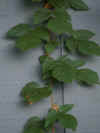| 06-28-04
With wild berry season upon us, fishing, and many other opportunities
available, outdoors types will be subjected to a world of pleasures . .
. and a universe of woes.
Lying in wait out there for unsuspecting outdoors people, are such misery
makers as poison ivy, poison oak, stinging nettles, mosquitoes, gnats,
no-see-ums, biting flies, ticks, chiggers, and who knows what else.
But an ounce of prevention, and follow-up procedures after exposure
can thwart the bad guys and make pleasant days tail off into pleasant memories.
Take, for example, one afternoon last week when I went, with berry pail
in hand, to the brush-infested banks of a small creek that was bordered
by waist-high corn.
Interspersed in the brush were small patches of wild black raspberry
canes--heavy with ripe, succulent berries. Unfortunately, intertwined in
the berry canes were infestations of lush, green poison oak, poison ivy,
and stinging nettles. And if that was not enough to flag down a berry picker’s
enthusiasm, "skeeters" whined around my ears, and I could only imagine
what other evils were about.
So what did I do? I dived in like picking black raspberries were going
out of style. In a little more than an hour my pail was full and I got
out of there--still much in one piece.
How did I escape the miseries that can befall an unsuspecting outdoors
person? It was easy.
First, I had anticipated the presence of the woeful forms of life I
would encounter by simply wearing sturdy, long trousers and a long-sleeved
shirt buttoned snugly about the wrists and neck. I had given my back and
neck a few squirts of a good insect repellent, and had rubbed both ankles
and the area around my waist with rubbing (Isopropyl) alcohol.
Then, when my bucket of berries was safely in the kitchen sink, I went
to the bathroom, sat on the edge of the tub and washed hands and arms above
the elbows, and feet and legs above the knees with a strong liquid soap
and water as hot as I could stand.
After patting hands, arms, feet and legs dry I doused my appendages
with a liberal coating of rubbing alcohol. I even put a little on the back
of my neck because it was a little itchy.
The next day I enjoyed a number of the plus features that can be derived
from a bucket of wild berries without suffering any of the consequences
that can come from an eyeball-to-eyeball encounter with the misery makers
of the wild.
Sure, I recognize and respect the evils of the outdoors. But when I
must mingle with the bad to harvest the good, I take my chances.
When I was a pre-teen kid at good ol’ Crothersville, I suffered (and
I do mean suffered) a mid-summer case of poison ivy rash that covered 60
percent of my body. My mother would bathe infected areas of my body with
a light paste made of lukewarm water and baking soda. Later I would learn
that calamine lotion is about as good as any treatment, other than dabbing
(drying with cotton) the fluids that seep from infested areas of the skin.
Another treatment of that era involved rubbing table salt into the fat
side of bacon rind, and massaging infected areas with the salty side of
the rind. That is not a joyous thing.
There are many remedies, including the old-time natural homespun medications
(many of which were used by native Americans) for the effects of all of
the evildoers of nature. But in the final analysis the old saw that says
”an ounce of prevention is worth a pound of cure” rings as true today as
it ever has been.
Learning to recognize the evils and to respect--but not fear--them is
the place to start.
Click
thumbnail image to see enlarged view.
 |
| The
poison ivy plant (shown here) tends to climb to great heights. Poison oak
usually grows in the form of a low shrub. Poison ivy and poison oak leaves
grow in clusters of three. |
|

